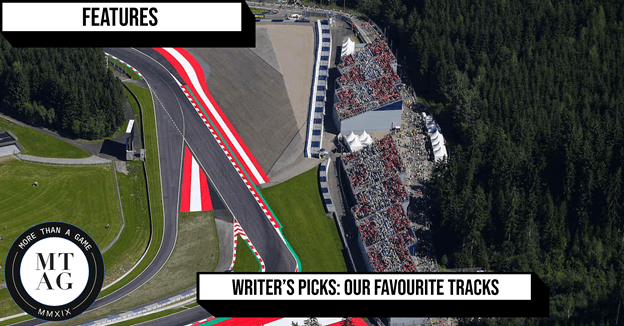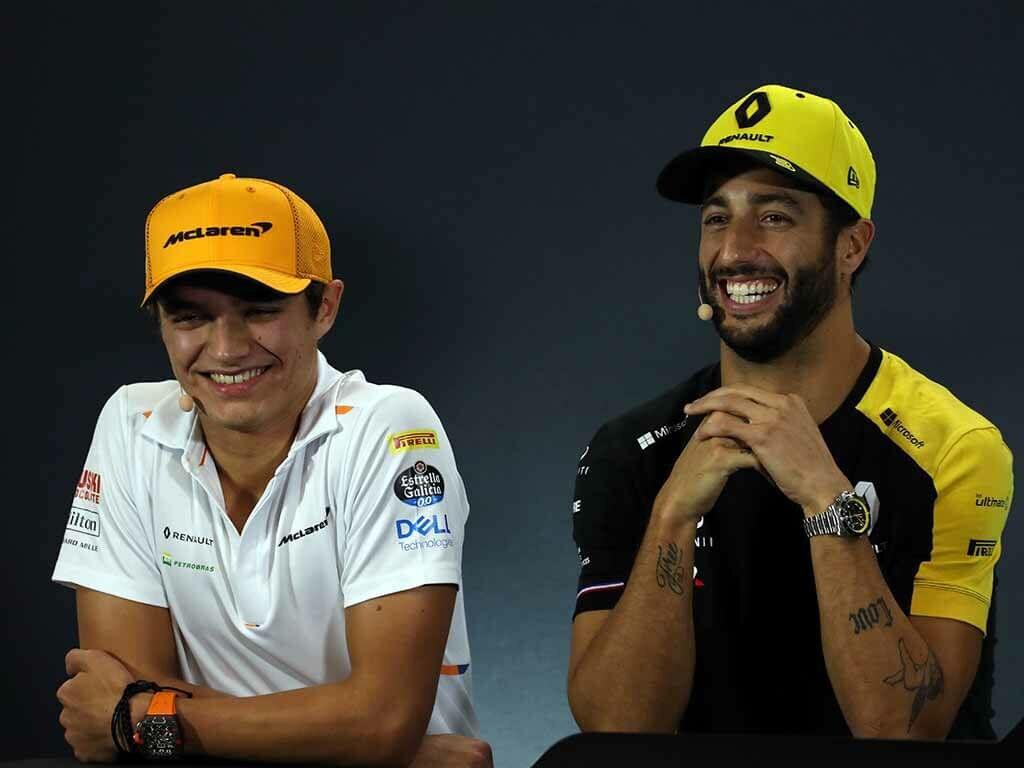THE MTAG WRITERS PICK THEIR FAVORITE F1 TRACKS
THE WRITERS ROOM | 26th March 2021

As the 2021 Formula 1 season dawns upon us, we thought to ourselves, “What is our favorite track in the history of the pinnacle of motorsports?”. Big, big question. And even though we love all the tracks, bar some, the MTAG writers have given it a long and hard thought as to which track is their favorite and why they think so.
Without further ado, let’s get into it.
Autodromo Nazionale Monza – Manish Sharma

Located in the northeast of Milan, the Autodromo Nazionale Monza is the epitome of power and speed. With a circuit length of 5.793 kilometers, Monza is a paradise for most drivers because of the long straights and sweeping corners providing them with ample opportunities of overtaking, leading to some breathtaking action.
While more than 80% of the circuit is as full throttle as can be, braking is also key at this high-speed circuit. From the Di Lesmos to the Parabolica, exiting the corners perfectly is vital at Monza, something which Ferrari’s Charles Leclerc learned the hard way when he crashed into the barricades last year at the end of the Parabolica.
As a Tifosi, Monza being a home race, expectations are always high from the Prancing Horse at the track. Leclerc’s race win in 2019 at the circuit, which was also Ferrari’s first win at the circuit since 2010, was an extremely satisfying moment as a fan, especially as he held off the challenge of Valtteri Bottas from Mercedes who were dominating the majority of the tracks in that season.
On the other hand, Pierre Gasly’s victory in last year’s dramatic race had a certain David vs Goliath feel to it but it reminded me of why I love the temple of speed and the sport of Formula 1 so much.
Circuit de Monaco – Harshvardhan Ghadge

Formula 1 is a sport as spectacular as any, but the world’s finest racing machines raging along the streets of Monte Carlo and past the Principality of Monaco might well be the most glamorous event in the world of sports. 92 years since William Grover Williams first won the Monaco Grand Prix and it still is the one track that every driver wants to conquer.
The best have raced on this track and met with triumph and tragedy. A tight, twisty 3.34 kilometer-long lap, 19 corners, featuring the slowest one in all of the championship means that over 21% of the lap is spent breaking, forcing a driver into over four thousand gear changes throughout the Grand Prix.
The famous ‘start straight’ has been a scene of many fast and chaotic starts going into Sainte Dévote. Whether it was David Coulthard tripping over the Ferraris in 1995 and 20 years later, Max Verstappen ramming into Grosjean’s rear wheels; no mistake goes unpunished in Monaco. The track is tricky when wet, but on the dry, it is no different.
It puts the viewers and drivers right on the edge of every single corner. But difficult corners bring out the true kings of Monaco. Ayrton Senna, Michael Schumacher, Alain Prost, all of them have ruled Circuit De Monaco and video footage of an onboard lap with any of these superstars is art in its finest form.
Every inch of tarmac used, every apex hit, is a visual spectacle. Million-dollar supercars flying along the harbour line of La Condamine, while the principality is lined with multi-million-dollar yachts when F1 comes to town, there’s no place you would rather be. Circuit De Monaco remains the jewel in Formula 1’s crown.
Hungaroring – Atul Kumar Maurya

The 4.381-kilometer circuit, situated in Mogyorod, Hungary is a hot, dusty and dry track just outside the city of Budapest. The circuit is a dusty one because of the sandy soil around the circuit and being an underused circuit just adds to it. But the specialty of Hungaroring is that it is way different from the rest of the underused circuits. This one doesn’t get faster over the weekend because of the gathering of rubber residue, the reason being the dustiness of the track.
Hungaroring brings back the memories of Nigel Mansell’s lost wheel in 1987, his race victory from 12th on the grid after dramatically overtaking Ayrton Senna in 1989 and Fernando Alonso’s maiden win in 2003.
Known as “Monaco without the buildings”, the twisty and bumpy nature of the track makes overtaking very difficult in dry conditions. But one of the most phenomenal races on the circuit was the 2006 Hungarian Grand Prix, a race which was the first-ever wet F1 race on the circuit. Jenson Button won the race after his fierce rivals Fernando Alonso and Michael Schumacher both retired out of the race.
As a fan of the track, the tight and twisty corners make the race even spicier for me when the racers get feisty while overtaking, as the overall track is a bit difficult to overtake on. This makes the qualifying even more important and hard-fought.
Another reason to love the track is that it is dry and physically demanding for the drivers, which in turn makes them orchestrate their skillset in the toughest of conditions. Being the home of the Hungarian motorsport, the F1 battles at the Hungaroring are a treat to the eyes.
Buddh International Circuit – Kabir Ali

You could call me biased for picking the track an hour down the road from where I live, but there were plenty more reasons to love the circuit that brought F1 to India. Although the BIC hosted only three races between 2011 and 2013, for me, being able to see the cars in the flesh and hear the last of the rip-roaring V8’s before the sport moved on to the turbo-hybrid era was unforgettable.
As for the track itself, F1 went with their track designer of choice, Hermann Tilke, who left imprints of his signature design language with a couple of long straights, a long, flat-out swooping bend and a few jinking corner sequences sprinkled in for good measure. The topography, with its elevation changes, evoked memories of Spa among the drivers, who received It as one of the more challenging and fun circuits across the calendar.
Slap bang in the middle of Red Bull’s era of dominance, Sebastian Vettel unsurprisingly won the three races here at a canter to become the undisputed king of Buddh. With the last of those wins, he also won the 2013 Drivers’ Championship and produced the most iconic image of the circuit’s brief history – having performed donuts on the main straight, the German got out of the RB9 to bow before it. It was to be both Vettel and Red Bull’s last championship, and this final hurrah was a fitting end for one of the sport’s finest driver-team duos.
Red Bull Ring – Aditya Gokhale

The Red Bull Ring is one of the best-looking circuits in the history of Formula 1. In between the Styrian hills, the 4.318-kilometer long track boasts its beauty as the cars drive through some stunning elevation changes. The legendary turn 2, or turn 3 depending on whose guide you check, has seen some of the most iconic overtakes as drivers slipstream through looking to make a move into turn 3.
The track requires a perfect combination of speed and precision as the grass runs close to the track, making even a single mistake costly. Ever since its reintroduction in 2014, the track has seen many iconic moments, whether it be title-rivals, Nico Rosberg and Lewis Hamilton crashing on the last lap in 2016 or Max Verstappen showing Charles Leclerc who the boss is, taking the lead with 2 laps to go in 2019.
It also saw the iconic team radio of Lando Norris in 2020 as he took 3rd place on the last lap after getting within 5 seconds of a penalized Lewis Hamilton.
The spectacle from the eyes of a spectator isn’t too shabby either. Sitting in the often cold and windy shade of the Styrian hills, while overlooking the iconic Steel Bull of Spielberg. The entrance showcases the statue of the late-great Jochen Rindt. The Red Bull is welcome sight for sore eyes.
Read More
RANKING THE 10 BEST LIVERIES FOR THE 2021 F1 SEASON FROM WORST TO BEST
KABIR ALI \
ESSENTIALS
2021 F1 SEASON: THE TOP 5 THINGS TO BE EXCITED ABOUT
ADITYA GOKHALE \
ESSENTIALS
INSIDE F1’S ONLINE TAKEOVER GONE GLOBAL
KABIR ALI \
FEATURES



